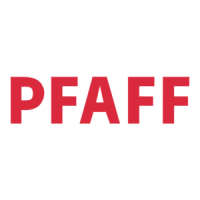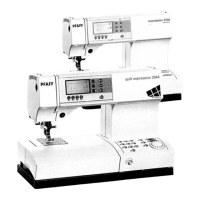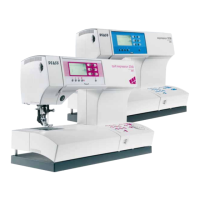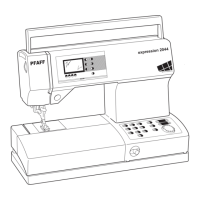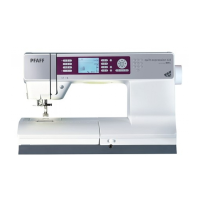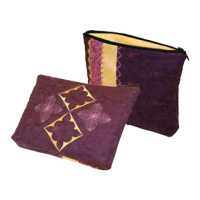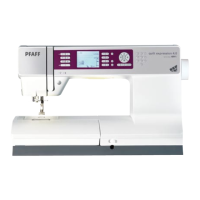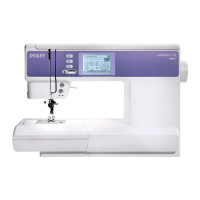Do you have a question about the Pfaff expression 2026 and is the answer not in the manual?
Details on included accessories and stitch patterns.
Illustrates and describes standard presser feet included with the sewing machine.
Introduces the range of utility stitches available on the sewing machine.
Introduces the range of decorative stitches available for embellishment.
Identifies and labels all external and internal components of the sewing machine.
Instructions for using the carrying case and opening the machine's lid.
Guides for connecting power, foot control, and understanding the main switch and voltage.
Explains how to remove the accessory tray and prepare for bobbin winding.
Detailed steps for winding bobbins from spool pin and threading the machine.
Instructions for handling the bobbin case and adjusting thread tension for optimal seams.
Step-by-step guide on how to correctly insert the bobbin and the bobbin case.
Procedure for threading the needle using the manual method.
Instructions on using the machine's built-in automatic needle threading system.
Covers presser foot lifter, drawing up bobbin thread, and using the thread cutter.
Guidance on changing presser feet and setting the needle thread tension.
Method for winding a bobbin while the machine is fully threaded.
Steps for changing the needle to a twin needle and threading it.
Explains how to engage and disengage the Integrated Dual Feed (IDT) system.
Procedure for lowering the feed dog for specific sewing tasks like free-motion quilting.
Methods for selecting stitches and adjusting stitch parameters like length and width.
How to alter stitch width, needle position, and pattern width for various stitches.
Techniques for adjusting stitch length, pattern length, and stitch density.
Adjusting stitch balance and using the reverse sewing function for reinforcement.
Using the pattern mirror feature and locking the machine settings.
Guidance on using a twin needle and understanding warning symbols.
Explains how different stitch patterns are formed and affected by width adjustments.
Table providing recommended settings for various sewing purposes.
Using the straight stitch for basic sewing and sewing in zippers.
Techniques for basting, topstitching, and managing thick seams.
Instructions for creating blind hems and elastic blind hems.
Using zigzag and stretch zigzag stitches for seams and decorative edges.
Applying elastic stitches for decoration and darning small damages.
Methods for repairing holes, tears, and creating honeycomb stitch hems.
Using various overlock stitches to join and finish fabric edges.
Procedure for sewing on two-hole and four-hole buttons using the machine's program.
Detailed steps for darning fabric damage using a straight stitch.
Methods for gathering fabric using straight stitches or elastic threads.
Creating hemstitching effects with bridging and decorative cross hem stitches.
Techniques for creating rolled hems using a hemmer attachment or stitch 3.
Creating a decorative shell edge finish, especially for thin fabrics.
Installing the buttonhole guide and attaching the correct presser foot.
Instructions for sewing fully automatic and semi-automatic buttonholes.
Sewing manual buttonholes and creating keyhole buttonholes.
Techniques for reinforcing buttonholes with gimp thread for durability.
Practical advice and recommendations for sewing perfect buttonholes.
General advice on decorative sewing, stitch adjustments, and presser foot selection.
Creating decorative borders by combining stitches and using a twin needle.
Steps for creating custom monograms using free-motion techniques.
Guidance on performing free-motion embroidery designs on fabric.
Techniques for tapering satin stitch width for decorative patterns.
Creating mitered corners with satin stitch and decorative buttonhole variations.
Methods for creating appliqué designs using fusible webbing and decorative stitches.
Techniques for patchwork, quilting, and achieving a hand-quilted look.
Instructions for embroidering cross-stitch patterns using the sewing machine.
Creating eyelet embroidery designs using special accessories.
Methods for producing hemstitching effects, including traditional and pulled thread techniques.
Procedures for changing the needle plate and cleaning the sewing machine.
Step-by-step guide on how to replace the sewing machine's light bulb.
Guidance on resolving common sewing problems and using non-original parts.
| Type | Sewing Machine |
|---|---|
| Brand | Pfaff |
| Model | expression 2026 |
| Presser Feet | 6 |
| Max Stitch Length | 6 mm |
| Built-in Needle Threader | Yes |
| Free Arm | Yes |
| Feed System | IDT (Integrated Dual Feed) |
| Display | LCD |
| Weight | 7.5 kg |
